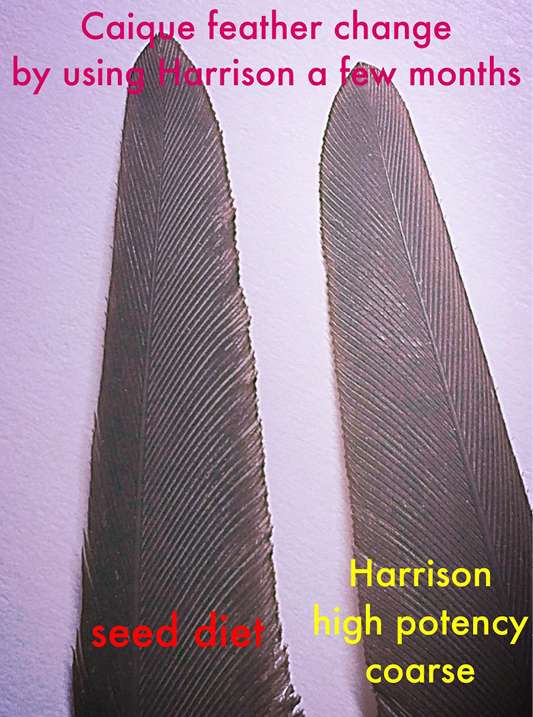What Your Bird’s Appearance Says About Its Overall Health
Feathers
Feathers show the critical first signs of impending disease, especially
if due to malnutrition. Birds in very early stages of illness include the
following characteristics:
- Feathers fail to zip (i.e., they have saw-toothed edges).
- Feathers are constantly in the developing (pin feather) stage. This is a form of hyperkeratosis, which is an accumulation or over-production of keratin in the surface layers of simple, squamous epithelium or structures derived from this skin layer.
- The bird experiences abnormal molts. This is usually only a partial molt and occurs with abnormal frequency. Birds may lose
small powder feathers periodically throughout the year. Major feathers (tail, wing) should be molted (lost and replaced with pin
feathers) once a year. Many malnourished birds partially molt several times a year and retain most of the large tail and wing feathers as well as rump, breast and neck feathers, which develop the signs that are outlined. A normal molt occurs when a bird is fed a proper diet. It may take up to (and occasionally over) one year to completely replace abnormal feathers. Abnormal feathers retained a second year following a diet change indicate further
evaluation procedures including organ function tests and perhaps biopsy. - Feathers are broken, bent, or missing.
- Feathers are dirty or stained (may be green stained around the vent from bile-stained urine).
- Feathers are inappropriately colored for the species (pink feathers instead of red; yellow instead of blue; black in green feathers; or yellow in white feathers). The color patterns of feathers should be vivid, intense and symmetrical.
- Affected feathers fail to snap back when bent or creased; they remain bent or are damaged; These imperfections may encourage the bird to over-preen, resulting in feather “chewing” or splitting.
- Feathers in malnourished birds are thin and translucent. When an unhealthy feather is held up to a light, one may be able to readily see through it.
Most of these problems are related to liver disorders, and the common cause is malnutrition. (The presence of yellow feathers in normal white feathered areas of cockatiels is a sign of liver disease and is just as serious as yellow skin is in mammals). Birds that are constantly fluffed up with drooped wings are often in the latter stages of illness or starvation. Feathers that are frequently misted with water are cleaner, stronger and exhibit less dust. Many birds enjoy showers.


Nails and Beak
Nails and beaks that are in a state of abnormally fast growth require constant trimming. This condition is usually related to liver disease, and malnutrition is a primary cause. The nails and beak (as well as skin and feathers) reflect metabolic disorders early in the disease process. The outer layer of normal nails and beak is shed as the tips wear off; with malnutrition, the outer layer is retained leaving a rough, jagged look to the surface. This is a form of hyperkeratosis.
Skin
Use the fingernail to evaluate the peeling (flaking) of the skin covering the feet and legs. The skin is a critical area to note some first signs of impending disease. The bottom of the feet is the most important skin surface to evaluate for pattern breaks and balding areas (pre-bumblefoot). Flaking, hyperkeratotic skin is less able to absorb pressure on the weight-bearing surface and tends to rip, tear, or wear thin. On the undersurface of the feet, this begins as pattern loss, then develops into balding and then ulceration (bumblefoot). Malnourished birds tend to develop slow-healing sores in areas of flexion and stretching. These areas are painful and lead to reluctance to move while the area itself may get over-preened, resulting in cannibalization.


Limbs
Many malnourished birds have weak tendons and sit on their hocks. Resulting bald spots are early signs of dietary imbalance. The wings are held in normal positions and appear to be painful due to the fragile nature of the ligaments and tendons. Such pain can lead to failure to stretch and preen, leaving long tail feathers bound in their sheaths.
Bleeding
Excessive bleeding could result primarily from liver dysfunction and is most often diet-related. When malnourished cockatiels crash against the cage walls when startled, they often bleed from their wing tips. African Greys may develop “red tears” when restrained.
Husbandry
Birds need an enclosure wide enough for them to open and flap their wings without touching the sides. This is a minimum – the larger the better. The enclosure needs to be free of accumulated feces and food. Sandpaper perches tend to create bald or sore spots on the feet. A cement perch may assist in keeping the nails short, but it can also cause sore feet if it is the only perch offered. Fresh branches from fruit, citrus, apple, eucalyptus, Australian pine, northern hardwoods, oak, melaleuca, aspen, or manzanita are good for birds’ feet. Perches need to be kept clean.
Access to natural sunlight is essential for activation of Vitamin D in the body.
Toxins
Overexposure to insecticides, herbicides, fungicides, preservatives, smoke, disinfectants, mycotoxins and rancid food can lead to illness. The First Aid Brochure* identifies other sources of toxins.
Droppings
Many birds in the early stages of illness (primarily involving the liver) show mild green in their urine (biliverdinuria) and urates (biliverdinurates); often this occurs months to years before clinical presentation of illness. The usual cause is malnutrition, although chlamydiosis, viruses, toxins, bacteria and yeast are also common. Very ill birds show scant feces, pasting of the vent or diarrhea. Normal birds’ feces show a pH of 6.8-7.0. Warm fresh feces should be examined for motile protozoa (Giardia, etc.).
